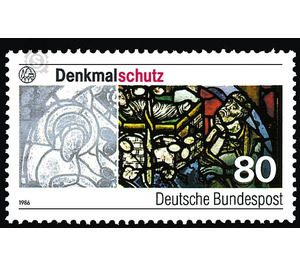listed - Germany / Federal Republic of Germany 1986 - 80 Pfennig
Theme: Art & Culture
| Country | Germany / Federal Republic of Germany |
| Issue Date | 1986 |
| Face Value | 80.00 |
| Color | multi-colored |
| Perforation | K 14 |
| Printing Type | 4-color offset printing |
| Stamp Type | Postage stamp |
| Item Type | Stamp |
| Chronological Issue Number | 1164 |
| Chronological Chapter | GER-BRD |
| SID | 864793 |
| In 43 Wishlists | |
With »Denkmalschutz« Deutsche Post continues the series of current topics. The stamp shows the example of medieval stained glass from the cathedral to Augsburg both the destructive power of air pollution, which does not stop at the precious cultural monuments, as well as the success of a meaningful monument protection. Cathedrals with their great works of art, castles and palaces, simple bourgeois houses, villas or abandoned coal mines, rural half-timbered buildings - all of them are testimonies of craftsmanship and artistic ability and reflect the lives of earlier generations. Who eliminates monuments, erases memories. Those who receive them also create the right to add something new. Only then does historical consciousness grow. In recent years, the protection of cultural monuments has increasingly found support from the general public. The value of our historical testimonies is experienced more consciously and has caused both citizens and politicians to stand up for their preservation. The danger of arbitrary demolition has diminished. Nevertheless, our monuments are by no means finally saved. Today you are exposed to other dangers. Thus, apart from the natural aging, the industrialization of building, of modern materials, of ignorance and thoughtlessness, in recent decades the contamination of soil, air and water has proved particularly disastrous for the monuments. The aggressive, man-made environmental pressures that experts have been complaining about at the turn of the century have alarmingly accelerated the natural aging process since the 1970's, leading to irreparable damage. The most important thing, the fight against air pollution and thus the elimination of causes at the source, is now included. The responsible persons are emphatically supported by the Ministers responsible for the preservation of historical monuments in Europe. You have achieved this goal at the occasion of your conference from 3 to 5 October 1985 in Granada a. a. affirmed by the signing of a European Convention on Historic Monuments and adopted a corresponding resolution. Also, initial research into the development of permanent protection systems is underway, because the environmental impact mechanisms are not yet fully understood, and the preservatives available today protect stone, metal and glass only imperfectly. But even with the favorable course of these efforts, much time will pass before the monuments are threatened by the environment any more. The monument conservators must therefore now set themselves up for a period of acute and to this extent unseen danger. In order to save the precious works of art in this time, must also be resorted to unusual measures. However, they can hardly be considered a permanent solution, they are merely emergency measures. At the same time, preservation, as far as it is possible today without consequential damage, comes first. However, where this conservation is not sufficient, the possibility of recovering endangered parts in shelters must be examined. The construction of protective roofs, depending on the local situation, can stop the destruction. Stained glass, which can not be adequately protected at the original place, must be temporarily removed or brought to safety by external protective glass. Detailed documentation is required for all these measures in any case. This includes the production of castings of valuable figurative, ornamental or architectural parts, of important inscriptions and a textual, graphic and photographic image of the current existence and condition. The great task of the rescue of monuments in the danger phase before us also requires an additional financial expense. A key role is the sustainable strengthening of funds for ongoing construction. In addition to research, the use of additional resources must above all benefit the recruitment and qualification of all the bodies and enterprises involved in the task. The forces currently employed in the preservation of monuments are often hopelessly overtaxed in terms of the tasks assigned to them. Every cultural monument that perishes today is lost forever. What we can not save now can never be saved. What we are missing now, can not catch up with future generations. (Text: Dr. Juliane Kirschbaum, Office of the German National Committee for Monument Protection at the Federal Ministry of the Interior, Bonn)


